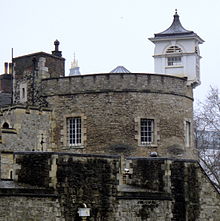Bell Tower (London)
The Bell Tower is a tower in the fortress complex of the Tower of London .
Location and function
The tower, built in the 1190s under Richard the Lionheart , is located directly at the entrance to the tower. Originally built as a fortification on the southwest edge of the tower, it has been protecting the area directly behind the gate in the Byward Tower since its expansion in the 13th century . After the White Tower , it is the oldest surviving tower on the fortress grounds.
It owes its name (German: bell tower ) to the bell that once hung there. There is still a framework for a bell on the parapet of the tower. This was rung every day when the gates were opened and closed, just as it was used in emergencies.
Both Cardinal John Fisher and Thomas More and Elizabeth I were imprisoned in the tower when they were held captive in the tower. The rooms in the Bell Tower were only accessible via the guards' lounge.
Elisabeth was locked up on the upper floor of the Bell Tower. During her imprisonment she had several servants with her and a total of four rooms for them. Her servants provided her with food and furnishings. In the last time of her captivity, Elisabeth was able to leave the Bell Tower and walk in the inner ring of the fortress.
While Elisabeth's imprisonment ended with transfer, release and the English royal crown, Thomas More only got to Tower Hill , where his execution took place. From the Bell Tower you can see Tower Hill, where the executions of those detained in the Tower were traditionally carried out. In the 16th century, the poet Thomas Wyatt was imprisoned in the Bell Tower , who had to watch the execution of his alleged lover Anne Boleyn from the tower . He put the experience into words:
"The Bell Tower showed me such a sight /
that in my head sticks day and night."
construction
The lower part of the Bell Tower is octagonal, the upper part round. This presumably stems from two construction phases, which were, however, very close together. Two now closed windows on the upper floor suggest a construction time around 1200 for this too. The current windows of the tower date from the 18th century.
When it was built, the tower rose 25 meters above the Thames, which at that time still reached directly to the base of the tower. To withstand the river, the lower part of the tower is made of marble . A fenced-off fountain on the southwest side of the tower still shows buildings that are below today's ground level (level of the 12th century).
The basement of the tower is completely filled with stone. The upper two - accessible - floors can each be reached separately through the Queen's House . On the first floor there is a small cloakroom anteroom, then a chamber with an irregular barrel vault . The unusually ornately designed upper chamber is roughly circular and has a dome-shaped ceiling. In it runs a continuously shaped horizontal projection that connects two arched openings. The staircase and staircase between the two floors probably fell out of use in the 14th century, and the remains of it were only found in 1970.
Individual evidence
- ↑ Tom Masters, Steve Fallon, Vesna Maric: London City Guide (Lonely Planet Guides). 7th edition. Lonely Planet, Footscray, Vic. 2010, ISBN 978-1-74179-226-3 , p. 119.
- ↑ William John Loftie: The Tower of London. A guide . Outlook Verlag, Berlin 2011, ISBN 978-3-86403-020-8 , p. 4 (English).
- ^ Peter C. Herman: A Short History of Early Modern England. British Literature in Context . Wiley-Blackwell, Oxford 2011, ISBN 978-1-4051-9560-7 .
literature
- Nikolaus Pevsner (greeting), Simon Bradley (arrangement): The buildings of London, Volume 1: The city of London . Penguin, London 1997, ISBN 0-14-071092-2 , p. 361.
Web links
Coordinates: 51 ° 30 ′ 28.1 " N , 0 ° 4 ′ 39.4" W.


